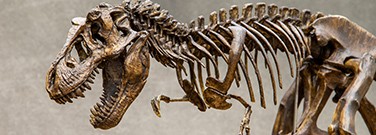The Bone that Gave T. rex a Crushing Bite

By Mike Howie
Tyrannosaurus rex, king of the dinosaurs, monster of our imaginations, could bite with force equal to the weight of a large male African elephant. Wielding over six metric tons of pressure, the T. rex could easily crush the bones of its prey. But how?
Flexible or Firm?
Like modern reptiles, T. rex had a joint in its lower jaw — the intramandibular joint, or IMJ. In some reptiles, like lizards and snakes, that joint is relatively flexible, making it easier to hold struggling prey or take a bigger bite. In others, like turtles and crocodiles, the joint is firmer to provide a stronger bite.
Many researchers have assumed that dinosaurs had flexible IMJs, but there was one problem: a flexible jaw couldn’t provide the biting power suggested by fossil evidence that included partially digested bone shards.
“There’s every reason to believe that T. rex could bite really hard, kinda off the charts,” said Lawrence Witmer, a vertebrate paleontologist at Ohio University. “It’d be nice to know how they could carry off these bite forces.”
Simulating the Bite
To find answers, John Fortner, a vertebrate paleontologist from the University of Missouri, and his team created a simulation of how T. rex’s mandible moved, which allowed them to study the stresses and strains the bones could absorb.
The simulation used two models based on a 3D scan of a T. rex skull. The key difference between these two models was how the researchers treated the prearticular, a boomerang-shaped bone that spans the IMJ. In one model, they left the bone intact. In the other, the team cut the bone in half and added virtual ligaments that would make the jawbone flexible.
When the team ran the simulation, they found that the model with the severed prearticular couldn’t effectively transfer stress across the IMJ and was too flexible to deliver crushing bite forces. The unaltered model, however, evenly transferred stress across the IMJ.
It appears that this relatively small bone is what braced T. rex’s jaw, locking together a complicated group of joined bones. The team presented this finding and their data on April 27, 2021, at the virtual annual meeting of the American Association of Anatomy.
Now that Fortner and his team have identified a key piece of the dino jawbone puzzle, they’re setting their sights on other, older members of the T. rex family. Those ancestors likely had a different feeding style that would have benefitted from a flexible jaw, making them an interesting specimen that could help chart the evolution of the IMJ.
Discussion Questions
- Other than sheer bite force, what tools did meat-eating dinosaurs have to bring down their prey?
- What other creatures have an IMJ, and how does it benefit them?
Vocabulary
- Ligament
- Mandible
- Paleontologist

